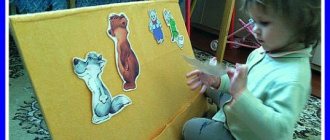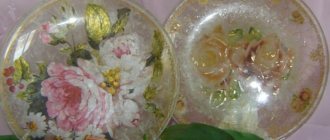Consultation for parents “Draw with your children”
Consultation for parents
Draw with your children
Children at any age love to draw. Even the smallest babies (not yet realizing that they are drawing) are delighted with the bright lines left by the felt-tip pen. Moreover, they draw with everyone and everywhere: with felt-tip pens and paints on paper, with crayons on the asphalt, with sticks on the sand. The young artist will always find a place for his new creation. But he doesn’t know why adults didn’t like this beautiful house on the new wallpaper in the nursery or Spider-Man on his mother’s annual report. Don't scold your baby. Better introduce him to new types of drawing.
Fingers - palette
. Dip your finger into liquid gouache and leave an imprint on the paper. It could be a rowan branch, a bouquet of flowers, beads, or fish.
Colored palms
. Dip your entire palm into a plate of gouache or paint it with a brush. Leave an imprint on the paper. What did you get? Jellyfish, goose, firebird, octopus or Indian Joe?
Monotype
. Fold a sheet of paper in half. Draw a butterfly wing on one half of it. Fold the sheet again along the fold to make a print. Draw the mustache. And now your butterfly is ready to fly away. Try drawing a tree reflected in the water, two symmetrical fish in an aquarium, or swans in a pond.
Drawing with a candle
. Draw a candle pattern on paper. Then paint over the leaf with watercolors. Everything you draw will magically remain white.
Nitcography.
Dip the thread into the paint. Lay out the image on a piece of paper, leaving one end free. Place another sheet on top, press it with your hand and pull the thread by the tip. What is this? Frosty patterns, a bouquet of flowers, moths or a magical dream?
Printing with leaves. Paint a sheet of wood from the side of the veins, apply the painted side to the paper. Complete the details. Did you end up with an aquarium with fish, a radiant sun or a forest?
Vegetable signets
. Take potatoes, radishes or carrots. Draw the intended shape on their end and cut off everything unnecessary. Dip the signet into the paint and press it onto a sheet of paper.
Screen printing
. Cut out a stencil from cardboard and press it onto a sheet of paper with your fingers. Dip a piece of foam rubber into the paint and paint over the stencil using frequent and light touches.
This is just a small part of the whole variety of drawing methods.
Well, have you already put your household chores aside? Then don’t waste time, because the colors are already ready to tell you a new story.
Literature:
1. Velikodieva Yu.V. Draw using unconventional techniques.
2. Drawing with preschool children. Non-traditional techniques, planning, lesson notes / Ed. R.G. Kazakova - M.: TTSsfera, 2006.
The works illustrating the text of the consultation were carried out by the author.
Consultation for parents “How to teach your child to draw”
Consultation for parents
On the topic “How to teach your child to draw”
Compiled by: Vaganova.M.G
Undoubtedly, preschool children consider visual activities the most interesting. Only after painting himself with felt-tip pens or smearing himself with watercolors does a child understand that there is happiness in life... How to teach a child to draw if you don’t know how to do it yourself? Don't rush to get upset. There are many techniques with which you can create original works, even without any artistic skills. Both you and your child will not only get pleasure from such activities.
The benefits of drawing
We adults sometimes don’t share this happiness, and we even feel indignant to the core when looking at the kid’s art on the walls in the apartment. But drawing is of great importance in shaping a child’s personality. Therefore, before scolding your child, try to direct his creativity in the right direction.
The baby only benefits from drawing. The connection between drawing and a child’s thinking is especially important. At the same time, visual, motor, and muscular-tactile analyzers are included in the work. In addition, drawing develops memory, attention, fine motor skills, teaches the child to think and analyze, measure and compare, compose and imagine.
For the mental development of children, the gradual expansion of the stock of knowledge is of great importance. It affects the formation of vocabulary and coherent speech in a child.
Agree, the variety of shapes of objects in the surrounding world, different sizes, variety of shades of colors, spatial designations only contribute to enriching the baby’s vocabulary. In the process of visual activity, the child’s mental and physical activity is combined. To create a drawing, you need to make an effort, work hard, mastering certain skills. At first, children develop an interest in the movement of a pencil or brush, in the marks left on paper; only gradually does the motivation for creativity appear - the desire to get a result, to create a certain image. Remember, each child is a separate world with its own rules of behavior, its own feelings. And the richer and more varied the child’s life experiences, the brighter and more extraordinary his imagination, the more likely it is that the intuitive craving for art will become more meaningful over time. “The origins of children’s abilities and talents are at their fingertips. From the fingers, figuratively speaking, come the finest threads - streams that feed the source of creative thought. In other words, the more skill in a child’s hand, the smarter the child,” argued V.A. Sukhomlinsky.
Imagination and fantasy are the most important aspect of a child’s life. And imagination develops especially intensively between the ages of 5 and 15 years. Along with a decrease in the ability to fantasize, children’s personality becomes impoverished, the possibilities of creative thinking decrease, and interest in art and creative activity fades. In order to develop creative imagination in children, a special organization of visual activities is necessary.
HOW TO TEACH A CHILD TO DRAW?
If you are already thinking that it’s time to teach your child to draw, try to follow the following principles:
Never ask your child to draw something specific for you, you can only offer several options to choose from, but do not insist that the child must draw something from what you suggest; Let him better draw what he himself has in mind.
Never criticize a small child's work; yes, he is still imperfect, he draws as best he can, but he draws with his soul; if you constantly criticize him, he may give up this activity altogether.
Never, under any pretext, add anything to the child’s work or improve it; this also offends him, emphasizes his inferiority, his inability to draw well himself (often parents do this so that they can later demonstrate the child’s work to relatives and friends as his achievements).
Never teach your child to draw any specific image, as this kills his imagination and puts stamps on certain images (your vision); It’s better to teach your child how to work with materials, draw different shapes, and he will benefit from these skills and will draw unusual, unlike anyone else’s images of this or that object or creature.
Encourage non-standard solutions for images or working methods; Let the child understand that the main thing is his imagination.
Review and discuss his previous works so that he does not forget that he already knows how to draw, that he has already done it very well once; Try to hang your child’s work on the wall.
Look at the work of other children so that he wants to draw the same.
Look at reproductions of paintings by different artists, go to art galleries.
What techniques for working with materials can you teach your child?
Methods and techniques of unconventional drawing.
BLOCKGRAPHY.
It consists of teaching children how to make blots (black and multi-colored). Then a 3-year-old child can look at them and see images, objects or individual details. “What does your or my blot look like?”, “Who or what does it remind you of?” - these questions are very useful, because... develop thinking and imagination. After this, without forcing the child, but by showing him, we recommend moving on to the next stage - tracing or finishing the blots. The result can be a whole plot.
DRAWING WITH TWO ON A LONG STRIP OF PAPER.
By the way, it is useful to change the paper format (i.e., give not only the standard). In this case, a long strip will help two people to draw without interfering with each other. You can draw isolated objects or scenes, i.e. work nearby. And even in this case, the child is warmer from the elbow of mom or dad. And then it is advisable to move on to collective drawing. The adults and the child agree on who will draw what to create one plot.
DRAWING WITH A SECRET IN THREE PAIRS OF HANDS.
When your child turns 4 years old, we strongly recommend using this method. It consists in the following. Take a rectangular sheet of paper and 3 pencils. The adults and the child are divided: who will draw first, who will draw second, who will draw third. The first one begins to draw, and then closes his drawing, folding the piece of paper at the top and leaving a little bit, some part, for continuation (the neck, for example). The second, seeing nothing but the neck, naturally continues with the torso, leaving only part of the legs visible. The third one finishes. Then the whole sheet of paper is opened - and it almost always turns out funny: from the mismatch of proportions and color schemes.
DRAWING YOURSELF or drawing your favorite toys from life. Drawing from life develops observation, the ability to no longer create, but to depict according to the rules, i.e. draw so that it is similar to the original in proportions, shapes, and color. Suggest that you first draw a picture of yourself while looking in the mirror. And be sure to look in the mirror many times. Better yet, show how you adults will draw yourself, making sure to look in the mirror many times. Next, let the child choose an object for himself. It could be a favorite doll, a bear, or a car. It is important to learn to observe for a long time, comparing parts of an object. And further. If a child deviates from nature, brings in something of his own, resulting in a completely different object or toy, do not be upset. Praise your child: “You drew a new car today! You probably want one like this?” But at the end of such a drawing, it is important to ask: “How does the drawn car differ from this one?”
“I DRAW MOM”...
It would be good to continue drawing from life or drawing from memory (family members, relatives and friends can become objects for such an image). As supporting material there may be photographs or conversations about the characteristic features of the appearance of absent relatives...Photos are taken and examined. A conversation is held: “What kind of grandmother is Valya? What is her hair like? Hairstyle? Favorite dress? Smile?" And the process of co-creation begins. After a while, you can offer to draw the girlfriends from memory. When you have collected enough drawings depicting relatives and friends, we advise you to organize a mini-exhibition “My Relatives and Friends,” where the first portraits of a preschooler are appreciated.
Children like everything unconventional.
Information for parents “Art activities for preschoolers”
Visual activities for preschoolers
Children's fine art is a world of bright, amazing images in which children convey their impressions of the reality around them. In our turbulent times, full of contradictions and anxieties, when the words “violence”, “immorality”, “lack of spirituality” have become commonplace, we seriously think about how our children will grow up. We adults are not able to isolate children from the surrounding reality. A rhetorical question arises: “What should we do?”, what methods should we use to educate morality? And here visual activity
. From a very early age, children need to be taught kindness, patience, the ability to help others, and adults should teach the child to see beauty and create a desire to create.
Visual activities in a preschool institution
...includes drawing, sculpting, applique and construction. The main goal of teaching visual arts is to develop children's creative abilities. In the process of depiction, the child acquires certain knowledge about the world around him and develops an attitude towards the object of knowledge and the pictorial object.
During the lesson, children acquire certain knowledge and skills in working with various materials, learn the properties of this material by experimenting with it. Children develop the creative ability to use skills in the process of depicting objects and phenomena of reality.
Visual activity contains great opportunities. It is a means of mental, emotional, aesthetic and volitional development of children. In the process of this activity, all mental functions are improved: visual perception, memory, mental operations. And the development of fine motor skills of the hand develops thinking and speech, because the hand, according to Kant, is the human brain pushed forward. The hand cognizes, and the brain records sensations and perceptions, combining them into images and ideas. Experiencing the beauty of the surrounding world and works of art, the child experiences positive emotions, on the basis of which deeper feelings arise: joy, admiration, delight, love and the beauty of the environment. A more complete perception of the world around us is facilitated by the integration of music, words and visual activities.
Parents should continue the work begun in kindergarten and create conditions for visual arts at home.
Tips for parents
It is advisable that children always have materials and supplies for classes at their disposal in a visible place. Children will be able to repeat the drawing they did in the Art class in kindergarten, add something, change it for the better, increasing their self-esteem.
Invite your child to paint his mood, his grievances and joys, his impressions of the day, and you will notice how his well-being improves, he becomes more calm.
When drawing, pay attention to the appropriate use of color. If the drawing contains a lot of dark, black colors, talk to the child, ask about his problems at this time, why he used these particular colors in his work. Perhaps this hides psychological problems, pressures, resentments, or negative attitudes towards him from peers or in the family.
Thus, drawing not only teaches certain skills, develops the child’s creative abilities and aesthetic taste, but also reveals him as a person, helping to solve problems of a psychological nature, express his attitude to the world around him, be more successful in society, confident and active.
Workplace organization
To make it convenient for your child to engage in creativity, organize for him a workplace that is appropriate for the height of the preschooler and has sufficient lighting.
For preschoolers who are about to go to school, it is better to buy an album with thick sheets. Let your child learn to draw on paper of this format, so he will feel more confident in lessons at school. Buy soft colored pencils, bright paints, brushes of different sizes.
A lot depends on the initial lessons in drawing and coloring. If you don't pay attention to how your child holds a pencil or brush, it can affect their preparation for school. His arm should not be tense, and his hand should be rigidly fixed. When drawing, it is important to be able to move freely and uninhibitedly.
Pay attention to the child's posture. To avoid tiring your spine, do not allow yourself to be creative for long periods of time. Take dynamic breaks. And don’t forget - the best rest is a change of activity.
Every child can learn to draw, sculpt, and carve if parents pay attention to these activities, if they patiently help children master skills and abilities and remember that visual creativity requires a lot of work, perseverance and interest from the child. It is very important that every child experiences the joy of creativity. N.K. Krupskaya said that “we need to help a child, through art, to more deeply understand his thoughts and feelings, to feel more clearly and deeply.”
We hope that these tips will help you develop your child's creative abilities!
Memo Art activity word DOCX / 532.66 Kb Art activity pdf PDF / 299.65 Kb
MAGAZINE Preschooler.RF
Maybe you have never thought about it, but every person has a need to draw. Regardless of how old you are and whether you know how to portray a rabbit. Has it ever happened to you that, after thinking, you start drawing something (drawing, shading, drawing circles with a pen on a sheet of paper)? This often happens, for example, during a lecture, a long or “nervous” conversation on the phone, at a time of anticipation or excitement. Drawing helps us release our feelings, thereby obtaining relief. And for the development of a child, the significance of drawing as a process and a result is generally difficult to assess and even describe in words. The importance of drawing for children Drawing is a process of incredible depth and meaning. Even completely unconscious and meaningless ones. If we talk about children's drawing, the first thing that comes to mind is the development of fine motor skills in this process. This is actually extremely important, and a child who starts drawing on time will most likely speak on time. And a countless number of techniques and various techniques in drawing allow you to develop the same fine motor skills with great interest.But this is far from the only and by no means the main meaning of drawing for a child. Probably, first of all, this is a way to develop a harmonious personality. Regardless, drawing is a creative process. The child can try himself and evaluate his capabilities, develop his aesthetic sides. With the help of drawing, the little artist not only reflects reality and the world, but also quickly learns about it. Any parent can turn a drawing lesson into a developing educational or exciting gaming activity. With the help of drawing you can learn shapes, colors, sizes, and spatial concepts. It’s also great to raise the creator’s self-esteem by praising him for his masterpieces every time. Drawing as isotherapy I would like to say something about this separately. Because the problem of children's fears, worries, and discomfort is familiar to many parents. By drawing it you can solve it, which psychologists call isotherapy. This is a whole separate topic! But in brief, the meaning of the method can be described as follows: invite the child to draw something that worries him or what he is afraid of. Perhaps he dreamed something at night or was hurt by other children in the garden. Or maybe he got scared of something during his daytime walk? Let him depict his fears on paper. Well, then you can do it in several ways. For example, you can turn something scary into something cute or helpless: an angry dog can be “put on a chain” and “put on a muzzle,” and in a dark room “put a cake with candles.” Several ideas for drawing together Drawing together is necessary not only because it is interesting. You can guide your child in one direction or another by consciously developing certain skills. So, it is very useful to teach your child to draw small details, since this is quite difficult for children. To do this, play “finishing drawings”. Draw, for example, a little man and ask him to complete the eyes, nose and mouth. Smaller children can be asked to draw apples on a tree or rays in the sun. It is useful for a two-year-old child to draw the following details: lines. This can be a separate drawing or the completion of yours. It’s a good game when a child draws the sea: at first it’s quiet and calm, and then it’s rough and stormy. Accompany the process with a story so that the baby feels a change of scenery: “It was sunny and quiet on the shore. The water sparkled and shimmered beautifully. But suddenly gray clouds came and a strong wind blew: the sea became angry and high waves began to grow.” Tasks like connecting common objects with lines or helping a bunny find its way to a carrot are also very good and interesting. And don't forget to praise! strokes. Hatching trains the pen to write very well and develops motor skills. And to make the learning process interesting, organize it in the form of a game. For example, you can draw a mouse and invite your child to “hide” it from the cat by shading each part of its body. points. The ability to draw such small details is very important. It could be rain or snow, polka dots on a doll's dress, a swarm of bees near the hive, and so on. stamps and seals. There are many different stamps on sale. But an equally good option can be made at home: from a foam sponge, potatoes, carrots, or bamboo cork. The game “who is hidden in the picture?” can help you learn to paint with a brush more easily. Draw the outline of some animal or object on a piece of paper with a wax candle and invite your child to find this image. Explain that to do this you need to paint the sheet with paint. Later, the baby can draw wax compositions himself. In general, it is advisable to use as many available tools as possible in the drawing process. It's very beautiful to draw with toothpaste. Make a drawing of a winter landscape by sketching lines with a pencil. Give your child a tube of white toothpaste and have him squeeze it out along the contours. Then offer to paint the composition. This is not only very beautiful, but also useful for the development of motor skills. Later it will be possible to master more complex techniques: drawing with cereals, for example. Particularly popular among children of all ages is drawing with a sponge (and other “stamps”), drawing on glass, mirrors, tables and other surfaces. The simplest idea is to play by drawing. Even if you don’t have a single toy at hand, but you have a pen and notepad lying around in your bag, you can have a very interesting time waiting in line at the children’s clinic. And here everything will be limited only by your imagination. You can draw a whole comic book for your child, coming up with an amusing story. Or take the doll off the keychain and draw for her a house in which she will live, and a garden in which she will walk and pick flowers. If a child creates a plot himself, pay attention to what, how and with what he draws. The predominance of dark colors may be evidence of a depressed or uncomfortable state of the baby. And portraying yourself as small and inconspicuous compared to other family members is a signal of low self-esteem and even intimidation. However, decoding children's drawings is another, no less interesting and useful topic.
| Next > |






